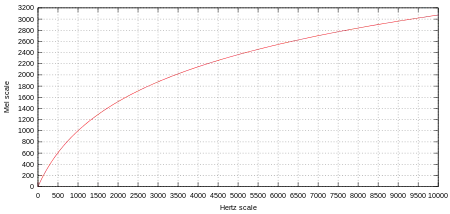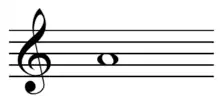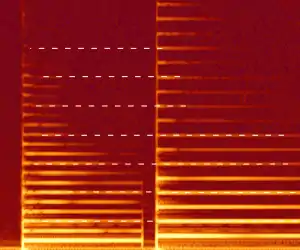Mel scale
The mel scale, named by Stevens, Volkmann, and Newman in 1937,[1] is a perceptual scale of pitches judged by listeners to be equal in distance from one another. The reference point between this scale and normal frequency measurement is defined by assigning a perceptual pitch of 1000 mels to a 1000 Hz tone, 40 dB above the listener's threshold. Above about 500 Hz, increasingly large intervals are judged by listeners to produce equal pitch increments. As a result, four octaves on the hertz scale above 500 Hz are judged to comprise about two octaves on the mel scale. The name mel comes from the word melody to indicate that the scale is based on pitch comparisons.


History and other formulas
There is no single mel-scale formula.[3] The popular formula from O'Shaughnessy's book can be expressed with different logarithmic bases:
The corresponding inverse expressions are:
There were published curves and tables on psychophysical pitch scales since Steinberg's 1937[4] curves based on just-noticeable differences of pitch. More curves soon followed in Fletcher and Munson's 1937[5] and Fletcher's 1938[6] and Stevens' 1937[1] and Stevens and Volkmann's 1940[7] papers using a variety of experimental methods and analysis approaches.
In 1949 Koenig published an approximation based on separate linear and logarithmic segments, with a break at 1000 Hz.[8]
Gunnar Fant proposed the current popular linear/logarithmic formula in 1949, but with the 1000 Hz corner frequency.[9]
An alternate expression of the formula, not depending on choice of logarithm base, is noted in Fant (1968):[10][11]
In 1976, Makhoul and Cosell published the now-popular version with the 700 Hz corner frequency.[12] As Ganchev et al. have observed, "The formulae [with 700], when compared to [Fant's with 1000], provide a closer approximation of the Mel scale for frequencies below 1000 Hz, at the price of higher inaccuracy for frequencies higher than 1000 Hz."[13] Above 7 kHz, however, the situation is reversed, and the 700 Hz version again fits better.
Data by which some of these formulas are motivated are tabulated in Beranek (1949), as measured from the curves of Stevens and Volkmann:[14]
Beranek 1949 mel scale data from Stevens and Volkmann 1940 Hz 20 160 394 670 1000 1420 1900 2450 3120 4000 5100 6600 9000 14000 mel 0 250 500 750 1000 1250 1500 1750 2000 2250 2500 2750 3000 3250
A formula with a break frequency of 625 Hz is given by Lindsay & Norman (1977);[15] the formula doesn't appear in their 1972 first edition:
For direct comparison with other formulae, this is equivalent to:
Most mel-scale formulas give exactly 1000 mels at 1000 Hz. The break frequency (e.g. 700 Hz, 1000 Hz, or 625 Hz) is the only free parameter in the usual form of the formula. Some non-mel auditory-frequency-scale formulas use the same form but with much lower break frequency, not necessarily mapping to 1000 at 1000 Hz; for example the ERB-rate scale of Glasberg & Moore (1990) uses a break point of 228.8 Hz,[16] and the cochlear frequency–place map of Greenwood (1990) uses 165.3 Hz.[17]
Other functional forms for the mel scale have been explored by Umesh et al.; they point out that the traditional formulas with a logarithmic region and a linear region do not fit the data from Stevens and Volkmann's curves as well as some other forms, based on the following data table of measurements that they made from those curves:[18]
Umesh et al. 1999 mel scale data from Stevens and Volkmann 1940 Hz 40 161 200 404 693 867 1000 2022 3000 3393 4109 5526 6500 7743 12000 mel 43 257 300 514 771 928 1000 1542 2000 2142 2314 2600 2771 2914 3228
Criticism
Stevens' student, Donald D. Greenwood, who had worked on the mel scale experiments in 1956, considers the scale biased by experimental flaws. In 2009 he posted to a mailing list,[19]
I would ask, why use the Mel scale now, since it appears to be biased? If anyone wants a Mel scale they should do it over, controlling carefully for order bias and using plenty of subjects – more than in the past – and using both musicians and non-musicians to search for any differences in performance that may be governed by musician/non-musician differences or subject differences generally.
References
- Stevens, Stanley Smith; Volkmann; John & Newman, Edwin B. (1937). "A scale for the measurement of the psychological magnitude pitch". Journal of the Acoustical Society of America. 8 (3): 185–190. Bibcode:1937ASAJ....8..185S. doi:10.1121/1.1915893. Archived from the original on 2013-04-14.
- Douglas O'Shaughnessy (1987). Speech communication: human and machine. Addison-Wesley. p. 150. ISBN 978-0-201-16520-3.
-
W. Dixon Ward (1970). "Musical Perception". In Jerry V. Tobias (ed.). Foundations of Modern Auditory Theory. 1. Academic Press. p. 412.
no one claims yet to have determined 'the' mel scale.
- John C. Steinberg (1937). "Positions of stimulation in the cochlea by pure tones". Journal of the Acoustical Society of America. 8 (3): 176–180. Bibcode:1937ASAJ....8..176S. doi:10.1121/1.1915891.
- Harvey Fletcher & W. A. Munson (1937). "Relation Between Loudness and Masking". Journal of the Acoustical Society of America. 9 (1): 1–10. Bibcode:1937ASAJ....9....1F. doi:10.1121/1.1915904.
- Harvey Fletcher (1938). "Loudness, Masking and Their Relation to the Hearing Process and the Problem of Noise Measurement". Journal of the Acoustical Society of America. 9 (4): 275–293. Bibcode:1938ASAJ....9..275F. doi:10.1121/1.1915935.
- Stevens, S. & Volkmann, J. (1940). "The Relation of Pitch to Frequency: A Revised Scale". American Journal of Psychology. 53 (3): 329–353. doi:10.2307/1417526. JSTOR 1417526.
- W. Koenig (1949). "A new frequency scale for acoustic measurements". Bell Telephone Laboratory Record. 27: 299–301.
- Gunnar Fant (1949) "Analys av de svenska konsonantljuden : talets allmänna svängningsstruktur", LM Ericsson protokoll H/P 1064
- Fant, Gunnar. (1968). Analysis and synthesis of speech processes. In B. Malmberg (Ed.), Manual of phonetics (pp. 173-177). Amsterdam: North-Holland.
- Jonathan Harrington & Steve Cassidy (1999). Techniques in speech acoustics. Springer. p. 18. ISBN 978-0-7923-5731-5.
- John Makhoul & Lynn Cosell (1976). "LPCW: An LPC vocoder with linear predictive spectral warping". ICASSP '76. IEEE International Conference on Acoustics, Speech, and Signal Processing. ICASSP 1976. 1. IEEE. pp. 466–469. doi:10.1109/ICASSP.1976.1170013.
- T. Ganchev; N. Fakotakis & G. Kokkinakis (2005), "Comparative evaluation of various MFCC implementations on the speaker verification task", Proceedings of the SPECOM-2005, pp. 191–194, CiteSeerX 10.1.1.75.8303
- Beranek, Leo L. (1949). Acoustic measurements. New York: McGraw-Hill.
- Lindsay, Peter H.; & Norman, Donald A. (1977). Human information processing: An introduction to psychology (2nd ed.). New York: Academic Press.
- B.C.J. Moore and B.R. Glasberg, "Suggested formulae for calculating auditory-filter bandwidths and excitation patterns" Journal of the Acoustical Society of America 74: 750-753, 1983.
- Greenwood, D. D. (1990). A cochlear frequency–position function for several species—29 years later. The Journal of the Acoustical Society of America, 87, 2592–2605.
- Umesh, S. and Cohen, L. and Nelson, D. (1999), "Fitting the mel scale", Proc. ICASSP 1999: 217–220, ISBN 978-0-7803-5041-0CS1 maint: multiple names: authors list (link)
- http://lists.mcgill.ca/scripts/wa.exe?A2=ind0907d&L=auditory&P=389
External links
 Media related to Mel scale at Wikimedia Commons
Media related to Mel scale at Wikimedia Commons- Hz–mel, mel–Hz conversion (uses the O'Shaughnessy equation)
- Volkmann, J; Stevens, SS; Newman, EB (1937). "A scale for the measurement of the psychological magnitude pitch". The Journal of the Acoustical Society of America. 8 (3): 208. Bibcode:1937ASAJ....8..208V. doi:10.1121/1.1901999.

